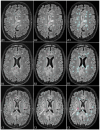Evaluation of two AI techniques for the detection of new T2/FLAIR lesions in the follow-up of multiple sclerosis patients
- PMID: 41132873
- PMCID: PMC12540099
- DOI: 10.3389/fneur.2025.1678073
Evaluation of two AI techniques for the detection of new T2/FLAIR lesions in the follow-up of multiple sclerosis patients
Abstract
Background: Multiple sclerosis is an inflammatory demyelinating disease of the CNS. Annual MRI exams are crucial for disease monitoring. Interpreting high T2/FLAIR lesion loads can be laborious. AI aids in lesion detection, and choosing between different solutions can be challenging.
Aim: This study compares two distinct software, Pixyl.Neuro.MS® and Jazz®, to assess their performance in T2/FLAIR lesion detection between two-time points.
Methods: Retrospective analysis included follow-up MRIs from 35 MS patients. Pixyl.Neuro.MS® automatically segments and classifies lesions. Jazz® automates the reading process and image display. Two readers (15 and 4 years of experience) conducted radiological analysis, followed by AI-assisted readings. A number of new lesions (NL) and reading times were recorded, with ground truth (GT) established by consensus. AI-detected lesions were classified as true (TP) and false positives (FP). Statistical analysis used SPSS (p < 0.05).
Results: Pixyl.Neuro.MS® readings averaged 2 min 46 s ± 1 min 4 s while using Jazz® 3 min 33 s ± 2 min 24 s. Over 50% of the population had a high lesion load (>20 lesions). Both software significantly improved NL detection (p < 0.01 for both), revealing them in more patients than standard readings. Standard reports found 8 NL in 2 patients, while AI-assisted readings detected at least 17 TP in 7 patients and rejected 61 FP lesions. GT detected 21 lesions in 19 patients.
Conclusion: Both AI software have been found to enhance NL detection in MS patients, outperforming standard methods. These tools offer crucial advantages for accurate disease monitoring.
Keywords: artificial intelligence; deep learning; lesion evaluation; magnetic resonance imaging; multiple sclerosis.
Copyright © 2025 Mastilović, Heinzlef, Federau, Muñoz-Ramírez, Blanchere, Boban, Cotton and Edjlali.
Conflict of interest statement
Verónica Muños-Ramírez is an employee at Pixyl SA. Christian Federau is the founder and CEO of AI Medical AG. The remaining authors declare that the research was conducted in the absence of any commercial or financial relationships that could be construed as a potential conflict of interest. The author(s) declared that they were an editorial board member of Frontiers, at the time of submission. This had no impact on the peer review process and the final decision.
Figures




References
-
- Baneke Peer. (2020). Atlas of MS 3rd Edition The Multiple Sclerosis International Federation. Available online at: https://www.msif.org/wp-content/uploads/2020/10/Atlas-3rd-Edition-Epidem... (Accessed June 25, 2025).
LinkOut - more resources
Full Text Sources
Miscellaneous

